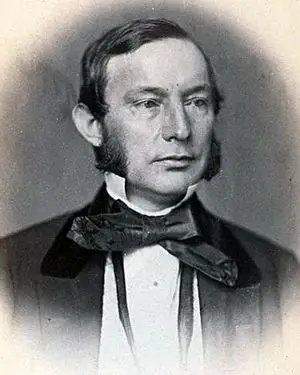Difference between revisions of "How did the Burlingame-Seward Treaty of 1868 change the relationship between China and the United States"
m (Admin moved page How did the Burlingame-Seward Treaty of 1868 change the relationship between China and the United States? to How did the Burlingame-Seward Treaty of 1868 change the relationship between China and the United States) |
|||
| (2 intermediate revisions by the same user not shown) | |||
| Line 1: | Line 1: | ||
| − | __NOTOC__[[File: | + | __NOTOC__[[File:AnsonBurlingame1859.jpg|thumbnail|left|300px| Anson Burlingame in 1859]] |
China and the United States concluded the Burlingame-Seward Treaty in 1868 to expand upon the Treaty of Tianjin of 1858. The new treaty established some basic principles that aimed to ease immigration restrictions and represented a Chinese effort to limit American interference in internal Chinese affairs. | China and the United States concluded the Burlingame-Seward Treaty in 1868 to expand upon the Treaty of Tianjin of 1858. The new treaty established some basic principles that aimed to ease immigration restrictions and represented a Chinese effort to limit American interference in internal Chinese affairs. | ||
| Line 21: | Line 21: | ||
* Republished from [https://history.state.gov/| Office of the Historian, United States Department of State] | * Republished from [https://history.state.gov/| Office of the Historian, United States Department of State] | ||
* Article: [https://history.state.gov/milestones/1866-1898/burlingame-seward-treaty| The Burlingame-Seward Treaty, 1868] | * Article: [https://history.state.gov/milestones/1866-1898/burlingame-seward-treaty| The Burlingame-Seward Treaty, 1868] | ||
| + | |||
| + | [[Category:US State Department]] [[Category:Wikis]][[Category:United States History]] [[Category:19th Century History]] [[Category:Diplomatic History]] | ||
Latest revision as of 21:25, 28 September 2021
China and the United States concluded the Burlingame-Seward Treaty in 1868 to expand upon the Treaty of Tianjin of 1858. The new treaty established some basic principles that aimed to ease immigration restrictions and represented a Chinese effort to limit American interference in internal Chinese affairs.
United States sought ties to China to increase trade
Anson Burlingame, a lawyer and former Republican representative to Congress from Massachusetts, became the U.S. Minister to China in 1861 and, under the orders of Secretary of State William Seward, worked to establish the United States as a power in the East. The United States wanted to gain access to profitable trading opportunities and foster the spread of Christianity in Asia, alongside the leading European nations, who also sought to gain inroads in China and Japan.
As a part of the general effort to convince the Chinese to adopt a more Western approach to diplomacy and governance, the Western powers also encouraged the Chinese Government to send diplomatic missions abroad. Finally persuaded to do so, the Chinese requested that Burlingame accompany their representatives on a tour that included stops in the major capitals of Washington, London, Paris, and Berlin. Burlingame, originally a representative of the U.S. Government, gave up his post to assist the Chinese in their treaty negotiations with Seward.
Burlingame and Seward sought to renegotiate the Treaty of Tianjin
While in Washington, Burlingame negotiated a treaty with Seward to revise and expand upon the points established in the Treaty of Tianjin of 1858. The first few articles of the new treaty-protected commerce conducted in Chinese ports and cities, and established the right of China to appoint consuls to American port cities. The more groundbreaking articles included measures that promised the Chinese the right to free immigration and travel within the United States, and allowed for the protection of Chinese citizens in the United States in accordance with the most-favored-nation principle. Another article gave the citizens of the two nations reciprocal access to education and schooling when living in the other country. All of these articles served to reinforce the principle of equality between the two nations.
The final article of the Burlingame-Seward Treaty offered China some protection from external influence in internal matters. In this article the U.S. recognized that the decision to begin new construction projects or similar improvements belonged in the hands of the local government, not foreign powers or their representatives. This point was intended to safeguard against undue U.S. involvement in Chinese domestic affairs.
Despite the reciprocal protections that the Treaty afforded Chinese in the United States and Americans in China, the Treaty ultimately reinforced U.S. trade interests with China under the principle of the most-favored-nation concept, and it ensured a steady flow of low-cost Chinese immigrant labor for U.S. firms. For these reasons, American industrial leaders initially celebrated the Treaty as a major advancement for American commercial interests.
Conclusion
However, the success of the treaty was short-lived. By the late 1870s, U.S. industrial leaders and politicians could no longer ignore the increasing anti-Chinese sentiment in the United States, particularly in the western states; in fact, industrialists and politicians often promoted anti-Chinese activities. A new treaty signed in 1880 revised the Burlingame-Seward agreement, and the Chinese Exclusion Act of 1882 abrogated its free immigration clauses altogether.
- Republished from Office of the Historian, United States Department of State
- Article: The Burlingame-Seward Treaty, 1868
